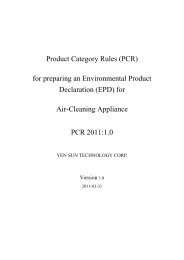Download(PDF) - PCR Library
Download(PDF) - PCR Library
Download(PDF) - PCR Library
Create successful ePaper yourself
Turn your PDF publications into a flip-book with our unique Google optimized e-Paper software.
Annex C (normative): Disposal and recycling scenarios for steel can<br />
Steel can scenarios applied to this <strong>PCR</strong> are below.<br />
C.1 Disposal and recycling flow<br />
The figure below shows a disposal and recycling flow of used steel can.<br />
Used steel<br />
can<br />
Waste treatment<br />
Recycling rate: R1<br />
1-R1<br />
1%<br />
53%<br />
46%<br />
Recycling scenario<br />
Recyclable waste<br />
collection<br />
Transport A<br />
Waste material<br />
collection<br />
Transport C<br />
Waste material<br />
collection<br />
Transport D<br />
Waste treatment scenario<br />
Collection from<br />
unburnable garbage<br />
Die-cutting scrap metals<br />
Intermediate<br />
treatment 1<br />
Intermediate<br />
treatment 2<br />
Figure C.1 Disposal and recycling flow of used steel can<br />
C.1.1 Disposal and recycling rate<br />
The steel can recycling rate is based on the value provided by the Japan Steel Can Recycling Association in<br />
FY2008.<br />
a) Recycling rate R1: 88.5%<br />
b) Percentage of steel cans that are recycled into converter steel R2: 12.6% (Percentage by industry of the amount<br />
of steel cans that are purchased by blast furnace manufacturers as scrap)<br />
C.1.2 Disposal and recycling stage<br />
Among steel cans that are collected as wastes (1 R1), 53% are subject to final disposal after intermediate<br />
treatment 2, and 46% are subject to final disposal without any intermediate treatment. Therefore, GHG emissions<br />
in the processes up to final disposal are included in the disposal and recycling stage. Also, among steel cans that<br />
are collected as wastes (1 R1), 1% is collected in intermediate treatment 2 and recycled. Therefore, GHG<br />
emissions in transport C and intermediate treatment 2 are also included in the disposal and recycling stage.<br />
For steel cans (R1) collected as recyclable waste, include GHG emissions of transport A and intermediate<br />
treatment 1 in the disposal and recycling stage.<br />
As for die-cutting scrap metals generated in the container/packaging production stage, include GHG emissions of<br />
intermediate treatment 1 in the container/packaging production stage.<br />
Source: "Research Project Report on LCA of a Container and its Packaging in FY2004" by the Institute for Policy<br />
Sciences, Japan (March 2005)<br />
C.1.3 Direct impact<br />
a) Among steel cans that are collected as recyclable garbage (R1), the ones that are mixed with steel cans<br />
collected from intermediate treatment 2 during intermediate treatment 1 ((1 R1) x 0.01) and die-cutting scrap<br />
metals generated in the container/packaging production stage, and that are recycled into converter steel (R2),<br />
shall be included in the container/packaging raw material acquisition stage.<br />
b) Calculate the effect of recycling of steel can into converter steel using the formulas shown below. Note that the<br />
converter aluminum end exemption formula shall be applied only when the secondary data "aluminum end<br />
metal and board manufacturing" of the container/packaging raw material acquisition stage is used.<br />
Recycling effect of converter steel = converter open-top can exemption + converter aluminum lid exemption<br />
Converter open-top can exemption = {S1 x R1 + [S1 x (1 R1) x 0.01] + S2} x R2 x (0.79 x GHG emissions from<br />
-15-<br />
Transport<br />
B<br />
Transport<br />
E<br />
R2 Recycling into converter steel<br />
1-R2<br />
Recycling into<br />
electric furnace<br />
steel<br />
Final disposal<br />
Crude steel<br />
manufacturing<br />
Iron ore mining<br />
Exemption of the<br />
direct impact<br />
Crude steel<br />
manufacturing<br />
Exemption of the<br />
indirect impact















